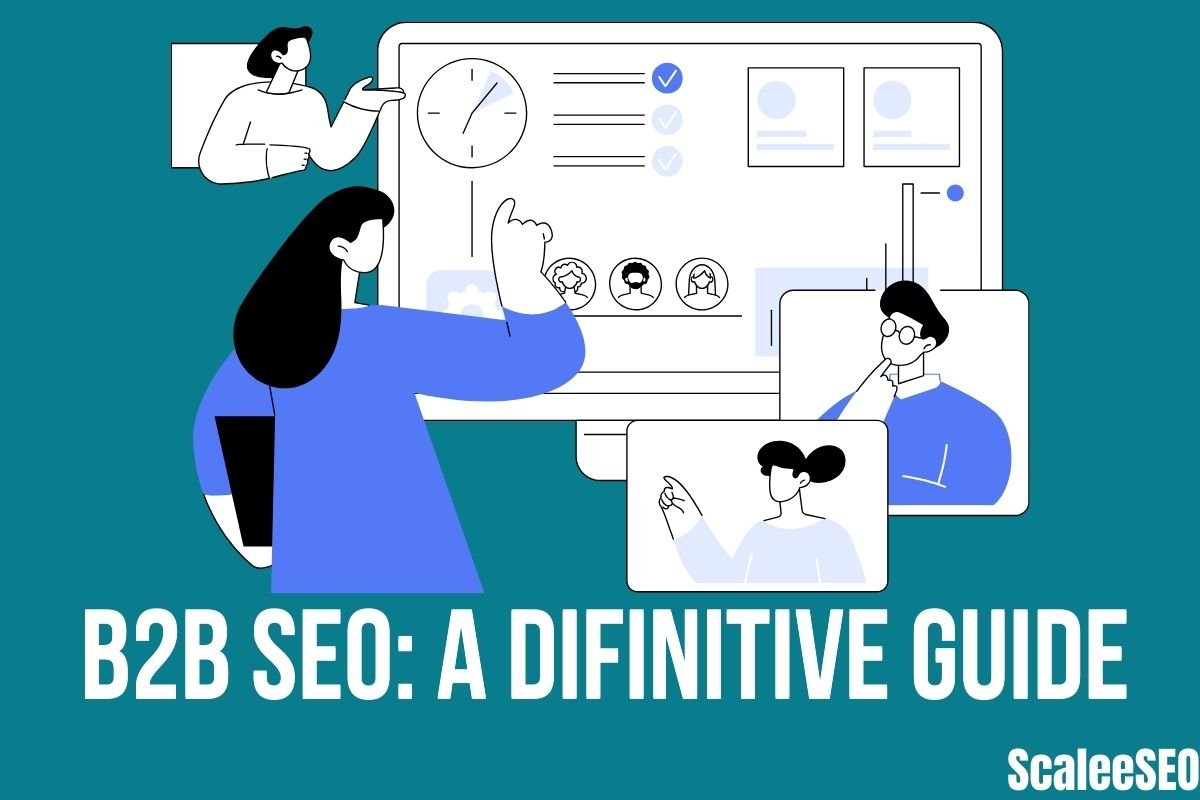
Today, you’re going to learn exactly how to master B2B SEO in 2025.
I’ve personally implemented the strategies that I’m going to share with you in this guide to help businesses generate thousands of qualified leads and dominate their industries.
And now, I’m sharing it all with you.
Let’s see the magic of creating a powerful B2B SEO Strategy can do for your site.
StarTech, A leading computer, laptop, and gadget shop in Bangladesh is driving Millions of traffic to their website per month that also organically means they are paying “ZERO” to Google.
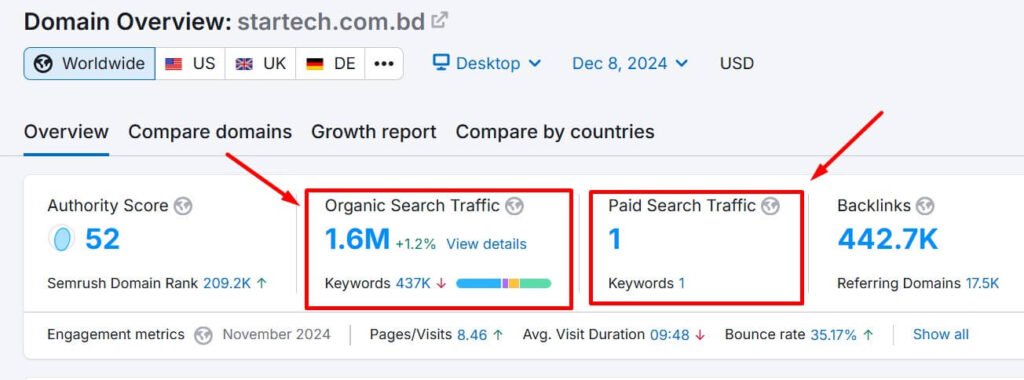
Voila, isn’t it magic?
Millions of traffic without spending a penny such a remarkable success
Right?
If I say, you can also do the same if you offer a B2B or Business to Business products/services and have a website to promote it.
In this guide, I’m going to share with you how you can drive lots of organic traffic (like start tech) to your website through creating an effective B2B SEO Strategy.
Here’s what you’ll discover:
- What is B2B SEO
- What makes B2B SEO different from B2C SEO
- How to build a strategy that attracts your ICP (Decision-Makers)
- The secret to finding the right keywords for your audience
- How to create content that converts into high-value leads
- Advanced link-building tactics for B2B SEO that actually work
- And many more
And that’s just the beginning.
Let’s dive in!
What is B2B SEO?
B2B SEO, or Business-to-Business Search Engine Optimization, is the process of optimizing your website and content to attract, engage, and convert business clients through search engines like Google.
Unlike B2C SEO or Business to Consumer Search Engine Optimization, which focuses on individual consumers, who are looking for your products/services for personal uses.
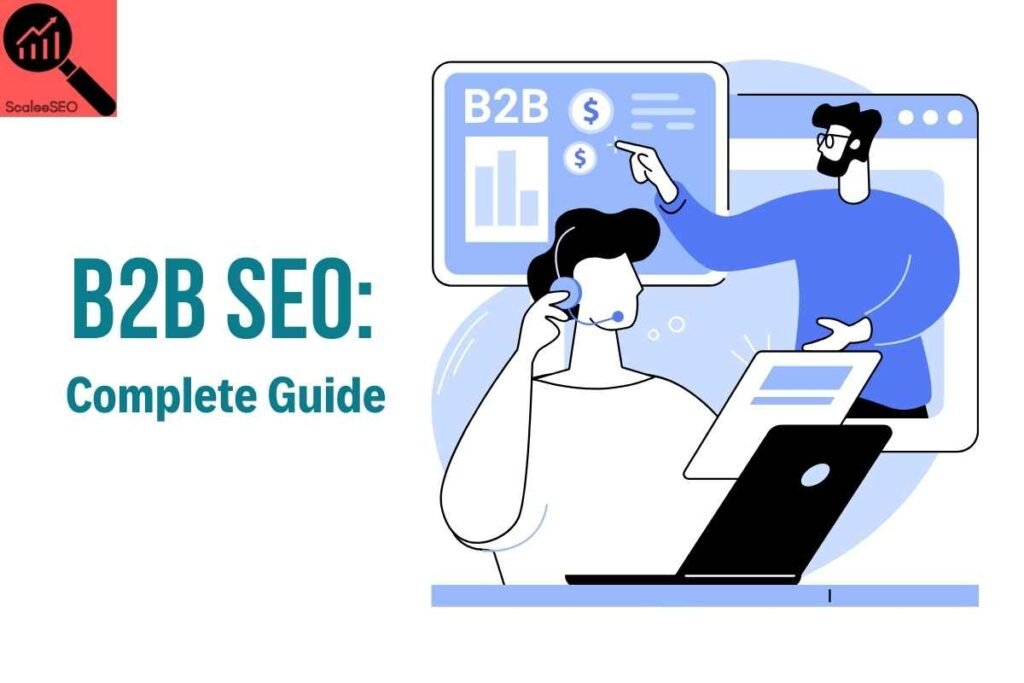
B2B SEO targets decision-makers within companies—people like CEOs, procurement officers, and department heads.
At its core, B2B SEO is all about:
- Driving Qualified Traffic: Attracting businesses actively searching for your products or services.
- Nurturing Leads: Guiding prospects through the buyer’s journey with relevant content.
- Building Authority: Establishing your brand as an industry expert.
Let’s break it down more into the next section, where you can see the actual distinction about B2B SEO Vs B2C SEO.
B2B SEO vs. B2C SEO
At first glance, SEO might seem universal—keywords, backlinks, and content, right?
But the truth is, B2B SEO is a completely different ballgame compared to B2C SEO.
Why?
Well, Because in B2B SEO you’re targeting a totally different audience than B2C SEO.
The distinction comes down to who you’re targeting (Who are your target customers), how they make decisions, and the overall complexity of the transaction.

Let’s break it down:
Target Audience
In B2C SEO, the audience is “straightforward”: individual consumers (Who are ready to buy your products and services for their personal benefits)
These could be “new moms,” “fitness enthusiasts,” or “college students,” often searching for personal needs and desires.
In contrast, B2B SEO targets businesses.
But here’s the kicker—it’s not just the business; it’s the decision-makers (Who takes the decision whether their business will need your products/services or not) within that business.
- Think: marketing managers, IT directors, CFOs, or CEOs.
- These people have specific goals (e.g., improving efficiency, reducing costs) and search for solutions with a business-first mindset.
A good example can be— A B2C consumer might search for “best headphones under $50,” while a B2B decision-maker could search for “enterprise video conferencing solutions for remote teams.”
Decision-Making Process
In B2C, buying decisions are often impulsive or emotional.
A catchy ad or an irresistible discount can close the deal for you.
But What about B2B decisions?
Can you guess?
I hope you guessed it right
Yeah! Not so fast.
- The process involves multiple stakeholders who evaluate options carefully.
- There’s a heavy emphasis on research, ROI, and long-term value.
This means B2B SEO must focus on providing informative, trust-building content like case studies, in-depth guides, and industry reports to help decision-makers make an informed choice.
Key Point: A B2C purchase might take minutes, while a B2B transaction could take months.
Marketing and Messaging
The way you speak to your audience also differs significantly.
In B2C SEO?
Often relies on catchy, emotional, or lifestyle-driven content.
- Example: “Feel amazing with these running shoes.”
But In B2B SEO?
Needs to be data-driven and solution-oriented. Has to create value or help them generate more ROI. Ouch!
- Example: “Improve team collaboration with our enterprise communication tools.”
In B2B, the content should address pain points and provide actionable solutions.
Messaging like “reduce operational costs by 30%” resonates far more than generic statements.
Product/Service Complexity
B2C products are usually simpler and require less explanation.
Think of a fitness tracker or a pair of sunglasses.
B2B products and services, on the other hand, can be highly complex.
They often involve:
- Technical specifications.
- Multiple features tailored to specific business needs.
- Implementation processes.
For instance, if you’re selling cloud-based ERP software, you’ll need detailed content like whitepapers, how-to guides, and case studies to explain its benefits and functionality.
Pricing and Transaction Size
In B2C, pricing is typically straightforward.
Consumers swipe their cards for purchases ranging from $10 to $1,000 without much back-and-forth.
But in B2B?
It’s a totally different story.
- Pricing is often negotiated, with costs running into thousands or even millions of dollars.
- The stakes are higher, so businesses expect customized solutions and clear evidence of ROI before committing with you.
While B2C SEO focuses on volume and appeal,
B2B SEO is all about precision, trust, and converting a niche audience.
Do you want to scale your business and become a brand in your niche?
At ScaleeSEO, A leading Digital Marketing Agency. Our B2B SEO Services can help you to achieve your desired goal. Let’s grow your business together.
And here are the steps for an effective B2B SEO strategy:
Step #1: Create your Decision Maker Persona
The first step in building a successful B2B SEO strategy is understanding exactly who you’re targeting.
- Who are your target customers?
- What types of services and products do they offer?
- Where are they selling their products/services?
In B2C, this step is pretty simple: you’re marketing directly to consumers.
For example, if you sell running shoes, your audience might be athletes or fitness enthusiasts. Simple, right?
But in B2B SEO, your target isn’t just a person—it’s a business.
And here’s where it gets a bit tricky: within that business, you’re not targeting everyone.
Instead, you need to identify key decision-makers who influence purchasing decisions.
These could be:
- A CFO evaluating cost-effectiveness.
- A marketing manager looking for tools to boost campaigns.
- A procurement officer responsible for selecting vendors.
Now, You might be wondering, How can you create your decision making persona?
Right?
Well no worries folks, I’m here to help you with this.
Let’s create your decision making persona together-
Here’s how to get started:
- Identify Your Ideal Customer Profile (ICP):
Think of your ICP as the type of business you want to work with.
Consider factors like:
- Industry (e.g., tech startups, manufacturing firms).
- Company size (small businesses vs. enterprises).
- Pain points they face (e.g., inefficiencies, growth challenges).
- Zero in on Decision-Makers:
Within your ICP, determine who holds the keys to purchasing decisions.
- Example: If you’re selling HR software, your decision-maker might be a VP of HR or a CEO.
- Map Out Their Challenges and Goals:
What keeps them up at night?
What are they searching for in Google to solve those problems?
- Example: A CFO might search for “cost-saving accounting tools”, while a marketing manager might look up “best B2B email automation software.”
It’s a super important step, so carefully find out what types of problems they are facing and how you can align your products/services to solve their problem.
There’s a bunch of good tools you can use to Build Your Decision-Makers Persona
HubSpot’s Make My Persona, An awesome personal building tool is one of them & can be incredibly helpful.
Here’s how it works:
- Name Your Persona: Give your decision-maker a name (e.g., “Marketing Mary” or “Finance Fred”).
- Add an Avatar: Choose an image or visual representation to humanize the persona.
- Fill in Key Details:
- Job title and responsibilities.
- Challenges they face in their role.
- Goals they’re trying to achieve.
Example: If your target is a procurement officer, your persona might look like this:
- Name: “Procurement Pat”
- Job Title: Procurement Manager
- Pain Points: Inefficient vendor processes, high operational costs.
- Search Intent: “Vendor management solutions” or “cost-effective supply chain tools.”
Why This Step is Crucial?
By creating a clear, detailed persona, you’ll know exactly:
- What content to create: Focus on solving their challenges.
- Which keywords to target: Align with their search intent.
- How to position your messaging: Show how your product or service addresses their specific needs.
Once you’ve nailed down your decision-maker persona, You’ll be ready to go to the next step.
Step #2 Conduct In-Depth Competitor Analysis
Your competitor is your goldmine.
They’re doing superb because search engines love them.
So, why are they special to search engines?
What are they doing differently?
You’ve to figure this out.
If you want to dominate B2B SEO, you need to know what your competitors are doing—and where they’re falling short.
Competitor analysis isn’t about copying;
It’s about finding gaps and opportunities to outshine the competition.
Don’t worry I’ll walk you through everything so you can do an in-depth analysis on your competitors.
To analyze your competitors properly, You need to go through three steps-
- Identify your top competitors.
- Analyze their SEO strategies.
- Pinpoint untapped opportunities.
Let me break down each step for you!
How to Identify your Top Competitors
Well, The first step is figuring out who your competitors are in the search engine results pages (SERPs).
You can do this manually by simply searching your keywords (A word or phrases that are used to describe a topic, or to help people find information online) into the search bar and see who are ranked for this keyword.
Example: If you target “B2B marketing automation tools,” you might find competitors like Gartner, HubSpot, etc.
These are the sites you are competing with.
Or
You can do also..
Use These Tools to Find your Competitors:
- Ahrefs or SEMrush: Enter your main keywords to see who’s ranking for them.
I’m using SEMrush as an example
-Got to SEMrush
-Login your account
-In the left section you can see lots of menus
-Go to <keyword Overview> Section under “Keyword Research”
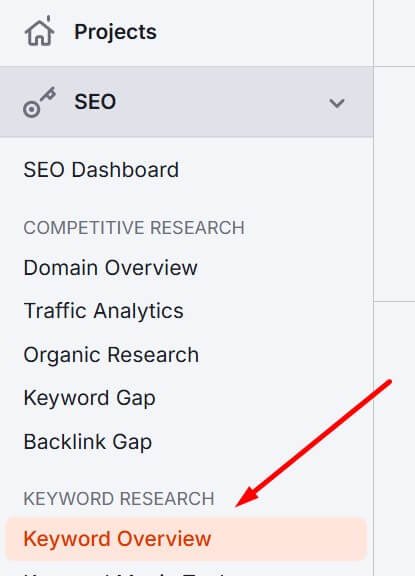
Put your keyword into the search bar and CLICK search

SEMrush will give you a lot of data.
But we don’t need that right now.
We’ll discuss them later.
What you’ll do now is, scroll down & you can see a section SERPs analysis
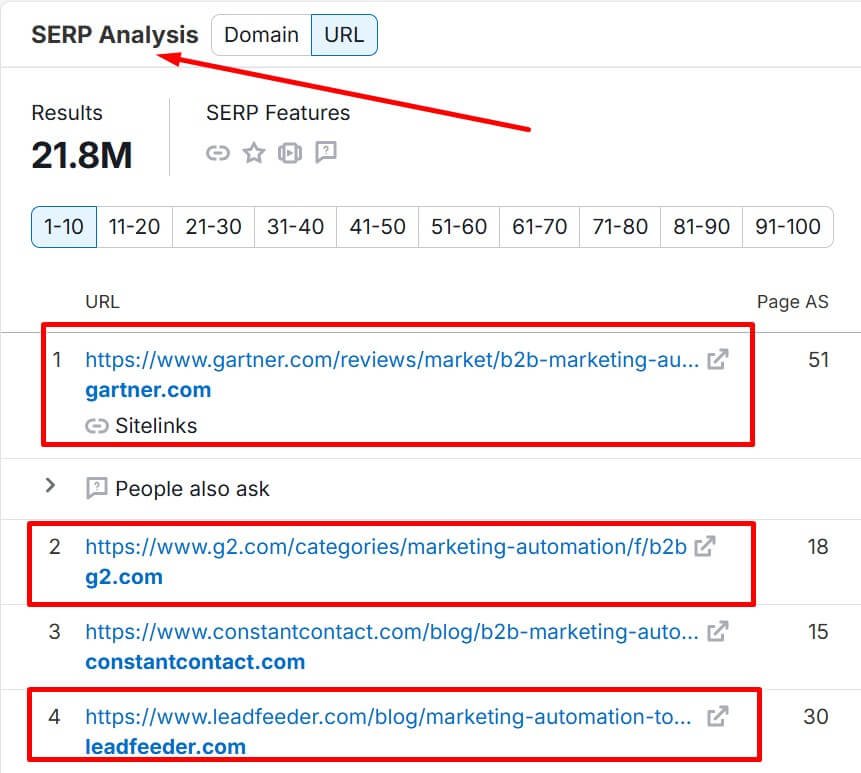
These are the results ranking for your keyword right now and also these are your competitors’ research on them.
- SimilarWeb: Discover sites that attract a similar audience to yours.
Analyze Their SEO Strategy
Once you’ve identified your competitors, it’s time to dig deep into their strategies.
Why do Google like them?
What are they doing differently?
Key Areas to Focus On:
- Keywords They Rank For:
- Use tools like Ahrefs or SEMrush to uncover the keywords driving traffic to their site.
- Look for high-value keywords (e.g., “best enterprise CRM software”).
- Content That Performs Well For Them:
- Check which blog posts, guides, or case studies are earning the most traffic.
- Example: If their post on “B2B lead generation tips” ranks well, it’s a sign the topic resonates with your audience.
- Backlink Profile:
- Analyze where their backlinks are coming from.
- Identify authoritative sites linking to their content—these could be your future link-building targets.
Identify Gaps in Their SEO Strategy
Here’s where you turn your findings into opportunities:
Look for Keywords They’re Missing:
- Use keyword gap analysis tools in SEMrush or Ahrefs to find terms they’re not targeting
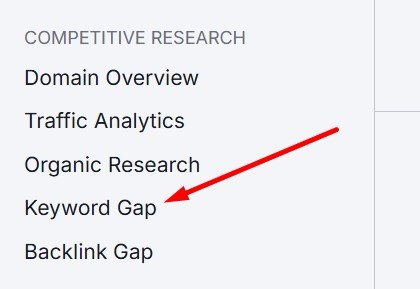
Example: If your competitor focuses on “B2B email marketing,” but skips “B2B SMS marketing,” that’s a content gap you can fill.
Spot Content They Haven’t Created:
- Are there trending topics or niches they haven’t addressed?
- Example: If they lack case studies or industry-specific guides, this is your chance to stand out.
Find Untapped Audiences:
- Who are they overlooking?
- Example: If their messaging speaks to large enterprises, you could target small-to-medium businesses (SMBs).
If you have read all of the above steps already, you might love my pro tip as well. Eh!
Pro Tip: Focus on Metrics That Matter
Not all data is equal. When analyzing competitors, prioritize these metrics (Metrics are data that measures how your strategy or tactics working):
- Organic Traffic Volume: Which pages drive the most visitors?
- Search Intent: Are their keywords informational, navigational, or transactional?
- Content Engagement: Are users spending time on their site, or bouncing quickly?
Now, You might thinking why you need competitors analysis,
Why will you do all of the above boring stuff?
Let me clarify you, A thorough competitor analysis allows you to:
- Save time and effort: Learn from what’s working (or failing) for others.
- Uncover opportunities: Target overlooked keywords and topics.
- Refine your strategy: Stay one step ahead by adapting to trends before they do.
Once you’ve nailed your competitor analysis,
You’re ready to move on to Step #3 which is related to finding profitable money keywords through comprehensive keyword research.
Step #3: Do Comprehensive keyword research to find ToFu, MoFu, BoFu Keywords
Keyword research is the foundation of any B2B SEO strategy.
It’s not just about finding the most popular keywords; it’s about identifying the right ones at every stage of the buyer’s journey—Top of the Funnel (ToFu), Middle of the Funnel (MoFu), and Bottom of the Funnel (BoFu).
In this step, I’ll show you how to find and organize keywords that align with your audience’s intent, ensuring your content drives traffic, nurtures leads, and converts decision-makers.
Let’s start,
What are ToFu, MoFu, and BoFu Keywords?
1. Top of the Funnel (ToFu), You can say Awareness-Stage Keywords
At this stage, your audience is just starting to research their problem.
They’re looking for general information and education.
Examples:
- “What is B2B marketing?”
- “How to generate leads for small businesses.”
These keywords attract visitors who are in the early stages of their journey and help establish your brand as a trusted resource.
2. Middle of the Funnel (MoFu): Consideration-Stage Keywords
Here, users are aware of their problem and are considering solutions.
They’re comparing options and seeking insights to make an informed decision.
Examples:
- “Best CRM software for B2B companies.”
- “Top lead generation tools for SaaS businesses.”
Pro Tip: Your content at this stage should focus on showing why your solution is the best fit through case studies, product comparisons, and in-depth guides.
And last and probably most important one for you.
3. Bottom of the Funnel (BoFu): Decision-Stage Keywords
These are high-intent, purchase-ready keywords.
Users at this stage are looking for specific products or services to solve their problems.
Examples:
- “Buy B2B email marketing software.”
- “Enterprise accounting software demo.”
This is where you want to target landing pages ( A web page that a user lands on after clicking on a Link) and product pages (A product page is a page where your products are listed) optimized for conversion.
As we knew the importance of ToFu, MoFu and BoFu.
Now let me tell you….
How to Find ToFu, MoFu, and BoFu Keywords for Creating your B2B SEO Strategy
1. Cluster Keywords by Intent
Group your keywords based on the user’s search intent:
- Informational (ToFu): Questions, definitions, and guides.
- Navigational (MoFu): Keywords with brand names or comparisons.
- Transactional (BoFu): Keywords with phrases like “buy,” “demo,” or “pricing.”
Example for a B2B SaaS Company:
| Intent | Keyword Example | Content Type |
| Informational | “What is CRM software?” |
Blog posts, FAQs |
| Navigational | “HubSpot vs Salesforce CRM” | Comparison guides, videos |
| Transactional | “Buy CRM for small business” | Landing pages, demos |
2. Focus on Long-Tail Keywords
Long-tail keywords are the keywords that are more specific and have lower competition, making them ideal for B2B SEO.
Example:
Instead of targeting “CRM software” (broad and competitive), aim for “best CRM for B2B sales teams.”
Long-tail keywords often align with MoFu and BoFu stages, where the intent is clearer and conversion rates are higher.
3. Use Advanced Keyword Research Tools
To find the best keywords, Use tools like:
- Ahrefs: Discover keyword difficulty, search volume, and related terms.
- SEMrush: Uncover competitor keywords and keyword gaps.
- Google Autocomplete: Superb to find long-tail keyword suggestions.
Pro Tip: Target Low-Competition Keywords
If your domain authority is lower than your competitors, focus on low-competition keywords that still have high purchase intent.
For example:
- High Competition Keyword: “B2B marketing automation.”
- Low Competition Alternative: “Affordable B2B marketing automation tools.”
By ranking for these keywords, you can start driving targeted traffic without competing against industry giants.
With your keywords organized by funnel stage,
You’re ready to move on to Step #4: Find Top of the Funnel Topics.
Step #4: Find Top of the Funnel Topics
Now, You’ve found the top of the funnel keywords and it’s time to convert those keywords into topics.
We’ll find the top of the funnel topics.
Top of the Funnel (ToFu) topics are your gateway to attracting new prospects.
These are the broad, informational topics your audience searches for when they’re just starting their journey.
At this stage, the goal isn’t to sell—it’s to educate, engage, and build trust.
When done right, ToFu content positions your brand as a valuable resource and draws in the decision-makers you want to reach.
ToFu Content Examples:
- Blog posts like “What is B2B SEO?”
- Guides such as “How to Generate Leads for Small Businesses.”
- Educational videos or infographics explaining industry trends.
These topics attract users who aren’t ready to buy yet but are looking for information—and your content can guide them toward the next step.
Now You’ll see….
How You Can Find Top Of The Funnel (ToFu) Topics
Here’s a step-by-step process to identify ToFu topics that resonate with your audience:
1. Start with Your Audience’s Questions
Ask yourself: What questions are your potential buyers asking in the early stages?
- You can use tools like AnswerThePublic or Quora to uncover common queries.
- Search for phrases like “how to,” “what is,” or “why does.”
Example: If you sell HR software, ToFu topics could include:
- “What are the benefits of HR automation?”
- “How to manage employee data effectively.”
2. Leverage Keyword Research
Keyword Research tools can help you find topics that your audience is actively searching for.
- Google people also ask sections or auto suggests to identify informational keywords with high search volume.
- Look for keywords with modifiers like “guide,” “tips,” “best practices,” or “examples.”
Example:
Instead of targeting “HR software,” which is competitive and transactional, aim for:
- “HR software benefits for small businesses.”
- “How to choose the right HR software.”
3. Analyze Competitor Content
Your competitors are likely already targeting ToFu topics.
Analyze their content to identify gaps or opportunities:
- Find topics they’ve overlooked or areas where you can provide more depth or unique insights.
Example: If a competitor covers “What is HR software?” you can add more value by creating “What is HR software, and how does it improve productivity?”
4. Monitor Industry Trends
Stay on top of what’s trending in your industry to create ToFu content that’s fresh and relevant.
- Follow industry blogs and news sites.
- Use tools like Google Trends to identify rising topics.
Example: A new regulation affecting your industry? Write a guide like:
“What [Regulation Name] Means for HR in 2025.”
Why ToFu Topics Are Crucial for B2B SEO
ToFu content isn’t about immediate conversions—
It’s about building awareness and trust.
Here’s what you can achieves by this:
- Increases Visibility: Broad topics with high search volume help attract more visitors.
- Builds Authority: Educational content positions you as an industry leader.
- Warms Up Leads: ToFu content brings prospects into your funnel, ready to engage with MoFu and BoFu content later.
Pro Tip: Use Content Formats That Engage
ToFu content works best when it’s digestible and visually appealing.
Experiment with:
- Blog posts and how-to guides.
- Infographics breaking down complex processes.
- Explainer videos for quick, engaging education.
With ToFu topics driving traffic to your site, you’re ready to optimize your content and move prospects further down the funnel.
Step #5: Optimize Your Website Product/Services
Now it’s time to optimize your product and service pages for SEO success.
Specifically, you’ll want to focus on aligning each page with one of the bottom-of-the-funnel (BoFu) keywords you identified earlier. These (BoFu) are high-intent search terms, meaning they’re used by people who are ready—or nearly ready—to take action.
But here’s the thing: on-page optimization is a massive topic.
If you want to dive deep, I recommend checking out our detailed resources like on-page optimization: A definitive guide
For now, let’s stick to the 80/20 tasks—the ones that deliver the biggest results with minimal effort.
Here are three strategies to optimize your B2B landing pages for better SEO ranking.
1. Write 100% Unique Content
Every product or service page needs to have unique, hand-written content.
Copy-pasting from other pages (even within your own site) can lead to duplicate content issues, which hurt rankings.
I know—this can be challenging.
Especially if your pages are similar, like:
- “Business WiFi Solutions” vs. “Office WiFi Solutions”
- Or different pages for services in multiple cities.
But here’s the ultimate truth: Google rewards originality.
If you want to rank higher, unique content isn’t optional—it’s a must.
Highlight features, benefits, or use cases that are unique to that page.
As they say: “Don’t hate the player. Hate the game.” 😉
Struggling to write content that converts?
No worries, ScaleeSEO offers a content writing service that delivers results and attracts high-intent leads to your site. Our dedicated expert writers, and editors are highly trained to write the best copy for your business that not only helps you rank well but also drives visitors and attracts them to take action.
Want to talk? We’re excited to contribute to your business success, let’s discuss.
2. Create Long-Form Content
Here’s a major issue with most B2B landing pages: they’re too thin.
Many have only 50–100 words of content, which isn’t enough for Google (or your readers) to understand what the page is about.
I recommend beefing up your content to at least 500–2,000 words—and for competitive topics, even longer.
Example:
The content you’re reading now contains 5,500+ words.
This helps Google understand the topic while providing readers with the in-depth information they need to take action.
3. Use Smart Keyword Placement
Google still uses keywords to rank a content.
And yes, you need to use your target keywords strategically. But don’t overdo it. Keyword stuffing can do more harm than good.
Instead, focus on strategic placement of your primary keyword while incorporating synonyms and variations to make the content natural.
Here’s how to use your keyword effectively in a content:
- H1 Title and Title Tag: Ensure your target keyword is front and center in your page’s main title.
- URL: Include your keyword in the URL (e.g., “/what-is-b2b-seo”).
- Meta Description: Write a compelling meta description using your keyword to boost click-through rates (CTR).
- First 50 Words: Try to mention your keyword early on the page.
- Synonyms and Variations: Sprinkle in related terms to capture semantic search.
Example:
For a page targeting “B2B marketing automation,” you might also use:
- “Enterprise marketing tools”
- “Automated marketing software for businesses”
A well-optimized page doesn’t just rank—it converts.
To boost your UX:
- Use clear headings to make content easy to scan.
- Add visuals like charts, infographics, or videos to enhance engagement.
- Include strong calls-to-action (CTAs): Examples like “Request a Demo” or “Schedule a Consultation” encourage next steps.
And that’s it for this section!
Step #6: Build Topical Authority
Building topical authority (a level of expertise and authoritativeness on a specific topic) is the key to becoming the go-to resource in your industry.
When Google sees you as an expert on a specific topic,
It rewards your site with higher rankings and increased visibility.
But topical authority isn’t just about creating random content—it’s about building a structured, interconnected content ecosystem that demonstrates depth and expertise.
Here’s how you can create one:
1. Create a Content Hub
A content hub is the foundation of topical authority.
Think of it as a central resource for a broad topic, supported by in-depth subtopics.
How to Build a Content Hub:
- Step 1: Choose a broad topic (pillar content).
- Example: “B2B SEO Best Practices.”
- Step 2: Write long-form pillar content that thoroughly covers the topic.
- This could be a 2,500+ word guide with sections on keyword research, competitor analysis, and more.
- Step 3: Create supporting blog posts (cluster content) for subtopics.
- Examples:
- “How to Conduct Competitor Keyword Research.”
- “Finding ToFu, MoFu, and BoFu Keywords for B2B SEO.”
- Examples:
- Step 4: Interlink your cluster content with the pillar page.
2. Highlight Case Studies and Testimonials
Nothing builds trust faster than real-world success stories.
Case studies and testimonials not only boost your credibility but also show Google (and your audience) that you’re a trusted expert in your field.
What to Include in a Case Study:
- The client’s challenge.
- How your product/service solved the problem.
- Measurable results (e.g., “Increased lead generation by 45%”).
Example:
If you offer B2B marketing software, create a case study titled:
“How [Client Name] Improved ROI by 200% with [Your Software Name].”
3. Publish In-Depth Content Regularly
Consistently creating high-quality, in-depth content is crucial for topical authority.
Btw…
Do you know what makes content “In-Depth?”
No problem, If you don’t…
Here’s the thing you should keep in mind to create an in-depth content
- Make sure your content covers the topic comprehensively (aim for 1,500+ words).
- Don’t forget to answer common questions and anticipate objections.
- Make your content rich with visuals like charts, infographics, or videos to enhance engagement.
Let’s see an examples of In-Depth Content:
- “A Complete Guide to B2B Lead Generation.”
- “10 Advanced Strategies for Building Topical Authority in B2B SEO.”
4. Strengthen Internal Linking
Internal links are essential for guiding users through your site and signaling content relationships to Google.
Internal Link is a powerful way to build topical authority and pass link juice (also called “link equity”) to other low authority pages but often overlooked by marketers.
But you shouldn’t
You should know how to implement the best practices of internal linking to extract the maximum output of it.
Best Practices for Internal Linking:
- Link from cluster content to your pillar page.
- Use descriptive anchor text to provide context.
- Avoid overloading pages with too many links—focus on quality over quantity.
5. Gain Backlinks from Authoritative Sites
Topical authority isn’t just about what’s on your site—
It’s also about who links to you.
How to Earn Quality Backlinks:
- Guest Blogging: Write for industry blogs to build credibility and earn links.
- Digital PR: Share unique insights or data to attract attention from high-authority publications.
- Content Outreach: Reach out to websites and offer your content as a resource.
Example:
If you’ve created a detailed guide on “B2B SEO Best Practices,” pitch it to sites that cover SEO or digital marketing.
After creating a few high quality backlinks now it’s time to update and optimize your existing content.
6. Update and Optimize Existing Content
Your old content can be a goldmine for building topical authority.
Take care of them
Here’s how you can Refresh your old Content:
- Add new statistics, case studies, or examples.
- Optimize for new keywords or trending topics.
- Improve readability with updated formatting and visuals.
Well after going through all of the above steps
You might have a questions
Why topical authority matters and how Topical authority helps you?
Right!
Well It helps you to:
- Rank for Competitive Keywords: Google rewards sites that demonstrate expertise.
- Attract Qualified Leads: Comprehensive content brings in decision-makers searching for solutions.
- Dominate Your Niche: Becoming the go-to resource builds trust and brand recognition.
Step #7: Create Super High-Quality B2B Blog
In the B2B world, a blog isn’t just a place for random updates—it’s a powerful tool for building trust, showcasing expertise, and driving qualified leads.
But to achieve all that, your blog needs to stand out.
That means creating super high-quality content that resonates with your target audience and provides real value.
Here’s how to create B2B blogs that engage decision-makers and help you dominate the search results.
1. Know Your Audience Inside-Out
The first step to creating high-quality B2B content is understanding who you’re writing for.
Ask yourself:
- What are their pain points?
- What questions are they asking?
- What solutions are they looking for?
Example: If you sell HR software, your audience might want to know:
- “How to automate employee onboarding.”
- “Benefits of HR software for small businesses.”
2. Write In-Depth, Actionable Content
When it comes to B2B blogs, fluff won’t cut it.
Decision-makers want detailed, actionable insights that solve their problems.
How to Write In-Depth Content:
- Cover the topic comprehensively, aiming for 1,500–2,500+ words.
- Break down complex concepts into simple steps or explanations.
- Use visuals like charts, graphs, and infographics to clarify key points.
Example:
Instead of writing a generic blog on “How to Improve Employee Retention,” create an in-depth guide titled:
“10 Proven Strategies to Boost Employee Retention in 2025 (With Case Studies).”
3. Focus on SEO Without Sacrificing Quality
SEO helps your blog get found, but your readers come first.
Strike a balance by creating content that’s both optimized for search engines and engaging for your audience.
SEO Best Practices for B2B Blogs:
- Target Specific Keywords: Use long-tail keywords like “best CRM for startups” or “how to generate B2B leads.”
- Optimize Headlines and Subheadings: Write clear, keyword-rich titles that spark interest.
- Use Internal and External Links: Guide readers to related content on your site and link to credible sources.
- Include Meta Descriptions: Write concise, click-worthy summaries of your blog.
4. Make Your Content Engaging and Easy to Read
No one has time to wade through dense, boring text.
Use formatting and storytelling techniques to keep readers hooked.
Engagement Tips:
- Use short paragraphs and bullet points to make content scannable.
- Add real-world examples or case studies to illustrate your points.
- Use a conversational tone that speaks directly to your audience.
Example:
Instead of saying, “One should consider ROI when choosing software,” write:
“When you’re evaluating software, ask yourself: Will this deliver the ROI my team needs?”
5. Incorporate Thought Leadership
Your blog is a chance to position your brand as an industry expert.
Go beyond the basics and share unique insights, predictions, or data-driven opinions.
How to Showcase Thought Leadership:
- Publish original research or surveys.
- Share predictions for your industry (e.g., “The Future of B2B Marketing in 2025.”)
- Write opinion pieces on hot topics affecting your niche.
Pro Tip: Thought leadership builds trust and credibility, making it more likely that your audience will choose your brand over competitors.
6. Promote Your Blog Strategically
Writing a great blog is only half the battle—
you need to make sure it gets in front of the right people.
Promotion Strategies:
- Email Marketing: Share your latest blogs with your subscriber list.
- Social Media: Post snippets or highlights on LinkedIn, Twitter, and other platforms where your audience hangs out.
- Guest Blogging: Reference your blog posts in guest articles on industry sites.
- Repurpose Content: Turn blog posts into infographics, videos, or LinkedIn posts to reach a broader audience.
Example: A blog post on “How to Optimize Your B2B Website” could be repurposed into:
- A LinkedIn carousel post.
- A short video tutorial.
- An infographic summarizing key tips.
7. Track and Improve Your Blog’s Performance
Your blog’s job doesn’t end at publishing. Regularly track performance and use the data to improve future posts.
Metrics to Monitor:
- Traffic: How many people are visiting your blog?
- Engagement: Are readers staying on the page or bouncing?
- Conversions: How many leads or sign-ups did the blog generate?
By creating engaging, SEO-friendly, and insightful blogs, you’re not just attracting visitors—you’re building relationships that lead to long-term success.
Now it’s time to..
Bonus: Develop a Link-Building Strategy
Backlinks still matter & one of the most important ranking factors though Google always denies it.
In fact
Link building is one of the most critical components of a successful B2B SEO strategy.
High-quality backlinks signal to search engines that your site is authoritative, trustworthy, and worthy of higher rankings.
But B2B link building is different from B2C.
Here, You’re targeting a niche audience with highly specific needs, so the focus should be on quality over quantity.
Here’s how to create a link-building strategy that works for your B2B business.
1. Focus on Earning High-Quality Backlinks
Not all backlinks are created equal.
In B2B, one link from an authoritative industry site can be worth more than 100 links from irrelevant blogs.
How to Identify High-Quality Backlink Opportunities:
- Industry Blogs and Publications: Target sites that cater to your specific niche (e.g., marketing blogs if you sell CRM software).
- Trusted Directories: Get listed in industry directories like Clutch or G2 for credibility.
- Partnership Links: Collaborate with your clients, partners, or suppliers to earn contextual links.
Pro Tip:
Avoid spammy or irrelevant links at all costs. They can harm your rankings and damage your reputation.
2. Leverage Guest Blogging
Guest blogging is a tried-and-true method for earning backlinks while showcasing your expertise to a broader audience.
How to Do It Effectively:
- Identify Relevant Sites: Use tools like Ahrefs Content Explorer or SEMrush to find sites that accept guest posts in your industry.
- Pitch Value-Driven Topics: Propose unique, actionable content that resonates with their audience.
- Example: For a B2B SaaS company, pitch a post like “5 Proven Strategies for Scaling Customer Success Teams.”
- Include Strategic Links: Link back to your site in a way that feels natural and relevant.
3. Build Links Through Digital PR
Digital PR involves sharing data-driven insights, trends, or unique resources to earn mentions from authoritative sites.
How to Launch a Digital PR Campaign:
- Create Original Research or Reports: Publish a study or survey related to your industry.
- Example: “2025 B2B Marketing Trends: Insights from 1,000 CMOs.”
- Pitch to Journalists and Bloggers: Use platforms like HARO (Help a Reporter Out) to connect with journalists looking for expert sources.
- Write Press Releases: Announce product launches, events, or milestones to attract attention from news outlets.
Pro Tip:
Make your data visually appealing with infographics or charts to increase shareability.
4. Use Broken Link Building
Broken link building is a powerful (and often underused) tactic. It involves finding broken links on other websites and suggesting your content as a replacement.
How to Do It:
- Use tools like Ahrefs or Check My Links to identify broken links on relevant sites.
- Reach out to the site owner, pointing out the broken link and offering your content as a replacement.
- Example Email:
“Hi [Name], I noticed that one of the links on your page [URL] is broken. I recently published a resource on a similar topic that might be a good replacement. Let me know if you’d like the link!”
- Example Email:
5. Create Linkable Assets
The best way to earn backlinks? Create content people want to link to.
Examples of Linkable Assets:
- Ultimate Guides: Comprehensive resources like “The Complete Guide to B2B SEO.”
- Infographics: Visual summaries of data or processes.
- Original Research: Reports, whitepapers, or surveys packed with valuable insights.
With a robust link-building strategy in place, you’re setting your site up for long-term success in search.



